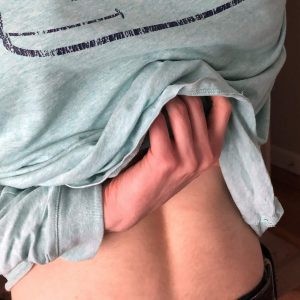Back itching can be incredibly bothersome, especially when the most irritating spots seem perpetually out of reach. It’s a common frustration to experience an itch right where you can’t quite scratch! While scratching might offer temporary relief, addressing the root cause of the itch is crucial. Often, the reason behind your itchy back goes beyond simple dry skin and could be attributed to conditions like irritant contact dermatitis or even a sensory neuropathy. Let’s delve into these potential causes and explore effective treatments.
Common Reasons for an Itchy Back
Simple Dry Skin (Xerosis)
Dry skin is frequently the primary culprit behind an itchy back. This is particularly true during the winter months when humidity levels drop, leading to overall drier skin. As we age, our skin naturally produces fewer lipids (oils), making us more susceptible to itchiness. Using a humidifier at home can help increase skin hydration, but the cornerstone of treatment is consistent moisturizing.
Applying lotion to your back can be challenging, particularly if you have limited shoulder flexibility. Asking for assistance from someone at home to apply moisturizer can be beneficial. If that’s not an option, a simple kitchen spatula can become a useful tool! By using a rubber spatula, you can extend your reach and effectively apply moisturizing lotion daily after showering to lock in moisture. Excellent moisturizer choices include creams like CeraVe Cream or Cetaphil Pro.
 Man intensely scratching his itchy back for relief
Man intensely scratching his itchy back for relief
Irritant Contact Dermatitis
If dry skin persists for an extended period, it can compromise the skin’s protective barrier, making it vulnerable to irritation from everyday substances. Common irritants include soaps, cleansers, and shampoos that come into contact with your back during showers. Even sweat can act as a significant irritant in some cases.
To mitigate irritant contact dermatitis, consider these helpful adjustments: take shorter showers, ensure your back is thoroughly rinsed after shampooing, and shower promptly after workouts to prevent sweat from lingering on your skin. After showering, gently towel dry and immediately apply moisturizer. If these measures don’t provide relief, irritant contact dermatitis might have developed, indicating that the skin is not just dry but also inflamed. In such instances, a dermatologist might prescribe a topical steroid to reduce inflammation, alongside recommendations for irritant avoidance and consistent moisturizing.
Notalgia Paresthetica
Some individuals experience a peculiar itchy patch that develops specifically on one side of the back, often under the shoulder blade – an area notoriously difficult to reach. This condition is known as notalgia paresthetica (NP), and it’s actually a type of sensory neuropathy. NP is quite common and characterized by sudden, intense itching in a defined area on the back. The itching can fluctuate in intensity without any apparent trigger. Some people also report localized burning, pain, tingling, or numbness in the affected area. Interestingly, the itch is often described as feeling “under the skin,” which accurately reflects its neurological origin.
Notalgia paresthetica itself doesn’t present with visible skin changes initially. However, dermatologists often observe secondary skin changes due to chronic scratching and rubbing. These changes can manifest as a localized patch of thickened, darkened skin just below the shoulder blade on one side of the back.
The exact cause of notalgia paresthetica remains unknown. However, factors like osteoarthritis, degenerative cervicothoracic disc disease, or direct nerve compression may play a role. Studies have indicated that a significant portion of patients with NP show X-ray evidence of disc disease in the cervical spine, suggesting that nerve impingement at the C4-C6 levels might be involved.
Because notalgia paresthetica is neurological rather than primarily a skin disorder, simply treating the surface skin irritation from scratching won’t address the underlying cause of the itch. Various therapies have shown promise in managing NP, including physical therapy, massage, chiropractic manipulation, transcutaneous electrical nerve stimulation (TENS), and acupuncture. Topical capsaicin cream, applied daily, can also be beneficial by depleting nerve endings of substance P, a neurotransmitter involved in itch and pain sensations. Capsaicin, derived from chili peppers, has demonstrated effectiveness in treating neuropathic pain conditions, including NP. Over-the-counter capsaicin cream can be applied to the affected area three times daily, and just like with moisturizers, a kitchen spatula can aid in application. Remember to wash your hands thoroughly after applying capsaicin cream to avoid eye irritation.
If you’re struggling with an itchy back, it’s advisable to put aside the back scratcher and consult a dermatologist. A dermatologist can accurately diagnose the specific cause of your itchy back and guide you toward the most effective treatment plan.